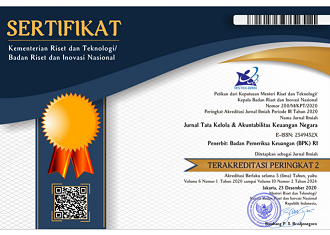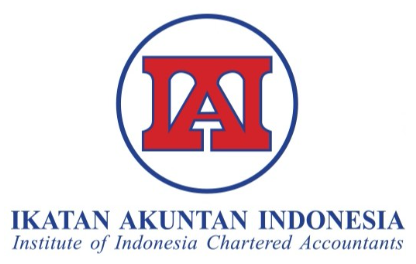Indonesia’s Capital Expenditure and Economic Growth 1990-2020: Role of Accountability
DOI:
https://doi.org/10.28986/jtaken.v7i2.653Keywords:
capital expenditure, Economic Growth, accountability, ARDL, long-term growthAbstract
This study examines the empirical relationship between capital expenditures and economic growth. It examines whether capital expenditures and accountability complement each other to encourage Indonesia's economic growth throughout 1990-2020. Using the autoregressive distributed lag (ARDL) bounds test, this study finds a cointegrated relationship between capital expenditure and economic growth in Indonesia during this period. In particular, capital expenditures have a negative impact on long-term growth. However, it is interesting that government capital expenditure with accountability shows a positive and significant effect on long-term growth. This demonstrates the importance of government accountability in managing government capital expenditures. This study implies that the government needs to increase accountability for the capital expenditures that have been realized to provide optimal benefits for Indonesia's economy in the long term.
References
Baldacci, E., Clements, B., Gupta, S., & Cui, Q. (2008). Social Spending, Human Capital, and Growth in Developing Countries. World Development, 36(8), 1317–1341. DOI: 10.1016/j.worlddev.2007.08.003
Bank Indonesia. (2020). Indonesia’s Economic and Financial Statistics of Bank Indonesia. Retrieved from https://www.bi.go.id/en/statistik/ekonomi-keuangan/seki/Default.aspx
Barro, R. J. (1991). Economic Growth in a Cross-Section of Countries. The Quarterly Journal of Economics, 106(2), 407. DOI: 10.2307/2937943
Baum, C. F. (2005). Stata: The language of choice for time-series analysis? Stata Journal, 5(1), 46–63. DOI: 10.1177/1536867x0500500110
Bose, N., Haque, M. E., & Osborn, D. R. (2007). Public Expenditure and Economic Growth: A Disaggregated Analysis for Developing Countries. The Manchester School, 75(5), 533–556. DOI: 10.1111/j.1467-9957.2007.01028.x
Easterly, W., & Rebelo, S. (1993). Fiscal policy and economic growth. Journal of Monetary Economics, 32(3), 417–458. DOI: 10.1016/0304-3932(93)90025-B
Furceri, D., & Li, B. G. (2017). The Macroeconomic (and Distributional) Effects of Public Investment in Developing Economies. IMF Working Paper. (17/2017). Retrieved from https://www.imf.org/en/Publications/WP/Issues
Gani, A. (2011). Governance and Growth in Developing Countries. Journal of Economic Issues, 45(1), 19–40. DOI 10.2753/JEI0021-3624450102
Gie, K. K. (2002). Pembiayaan Pembangunan Infrastruktur dan Permukiman. Retrieved from https://www.bappenas.go.id
IMF. (2015). Making Public Investment More Efficient. Washington, DC. Retrieved from http://www .imf .org/external/ np/ pp/eng/ 2015/061115 .pdf.
King, R. G., & Levine, R. (1994). Capital fundamentalism, economic development, and economic growth. Carnegie-Rochester Conference Series on Public Policy, 40, 259–292. DOI: 10.1016/0167-2231(94)90011-6
Kripfganz, S., & Schneider, D. C. (2018). ARDL: Estimating autoregressive distributed lag and equilibrium correction models. London Stata Conference September 7, 2018.
Lucas, R. E. (1988). On the mechanics of economic development. Journal of Monetary Economics, 22(1), 3–42. DOI: 10.1016/0304-3932(88)90168-7
Lütkepohl, H. (2005). New Introduction to Multiple Time Series Analysis. Springer-Verlag.
Mankiw, G. N., Romer, D., & Weil, D. N. (1992). A contribution to the empirics of economic growth. Quarterly Journal of Economics, 107(2), 407–437. DOI: 10.2307/2118477
Mendy, D., & Widodo, T. (2018). Do education levels matter to Indonesian economic growth? Economics and Sociology, 11(3), 133–146. DOI: 10.14254/2071-789X.2018/11-3/8
Milbourne, R., Otto, G., & Voss, G. (2003). Public investment and economic growth. Applied Economics, 35(5), 527–540. DOI: 10.1080/0003684022000015883
Miyamoto, H., Baum, A., Gueorguiev, N., Honda, J., & Walker, S. (2020). Well Spent How Strong Infrastructure Governance Can End Waste in Public Investment, Chapter 2: Growth Impact of Public Investment and the Role of Infrastructure Governance (G. Schwartz, M. Fouad, T. S. Hansen, & G. Verdier (eds.)). International Monetary Fund. DOI: 10.5089/9781513511818.071
Moosa, I. A. (2002). Foreign Direct Investment Theory, Evidence and Practice. N.Y: Palgrave.
Narayan, P. K. (2005). The saving and investment nexus for China: evidence from cointegration tests. Applied Economics, 37(17), 1979–1990. DOI: 10.1080/00036840500278103
Onifade, S. T., Çevik, S., Erdoğan, S., Asongu, S., & Bekun, F. V. (2020). An empirical retrospect of the impacts of government expenditures on economic growth: new evidence from the Nigerian economy. Journal of Economic Structures, 9(1), 6. DOI: 10.1186/s40008-020-0186-7
Pesaran, M. H., & Shin, Y. (1997). An autoregressive distributed lag modeling approach to cointegration analysis. Econometrics and Economic Theory in the 20th Century: The Ragnar Frisch Centennial Symposium., March 3-5, 1995, 1–31.
Pesaran, M. H., Shin, Y., & Smith, R. J. (2001). Bounds testing approaches to the analysis of level relationships. Journal of Applied Econometrics, 16(3), 289–326. DOI: 10.1002/jae.616
Romer, P. M. (1986). Increasing Returns and Long-Run Growth. Journal of Political Economy, 94(5), 1002–1037. Retrieved from http://www.jstor.org/stable/1833190
Samarasinghe, T. (2018). Impact of Governance on Economic Growth. Munich Personal RePEc Archive. Retrieved from https://mpra.ub.uni-muenchen.de/89834/
Solow, R. M. (1956). A Contribution to the Theory of Economic Growth. The Quarterly Journal of Economics, 70(1), 65. DOI: 10.2307/1884513
Temple, J. (1999). The New Growth Evidence. Journal of Economic Literature, 37(1), 112–156. DOI: 10.1257/jel.37.1.112
UNDP. (2020). Human Development Reports. Retrieved from http://hdr.undp.org/en/data
Warner, A. M. (2014). Public Investment as an Engine of Growth (IMF Working Paper 14/148). Retrieved from https://www.imf.org/external/pubs/ft/wp/2014/wp14148.pdf.
Wößmann, L., & Hanushek, E. (2007). The Role of Education Quality in Economic Growth. World Bank Policy Research Working Paper, 4122, 1–94.
World Bank. (2020a). World Development Indicators (WDI). Retrieved from https://data.worldbank.org/country/ID
World Bank (2020b). Worldwide Governance Indicator (WGI). Retrieved from https://info.worldbank.org/governance/wgi/
Downloads
Submitted
Accepted
Published
How to Cite
Issue
Section
License

Jurnal Tata Kelola dan Akuntabilitas Keuangan Negara is licensed under
a Creative Commons Attribution-ShareAlike 4.0 International License




















